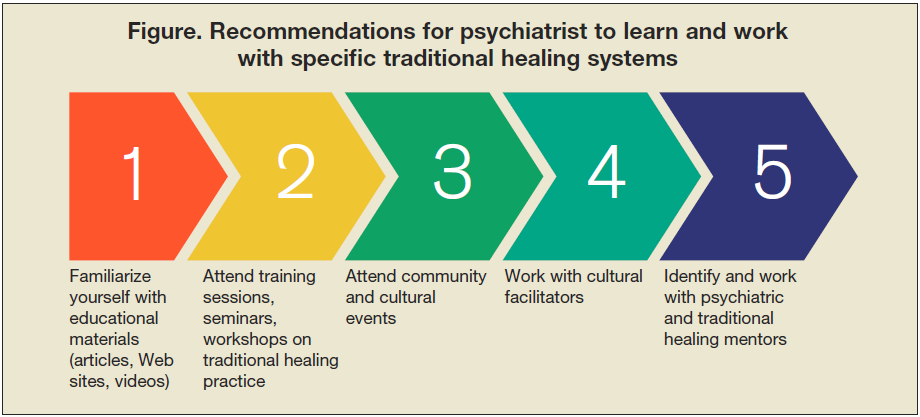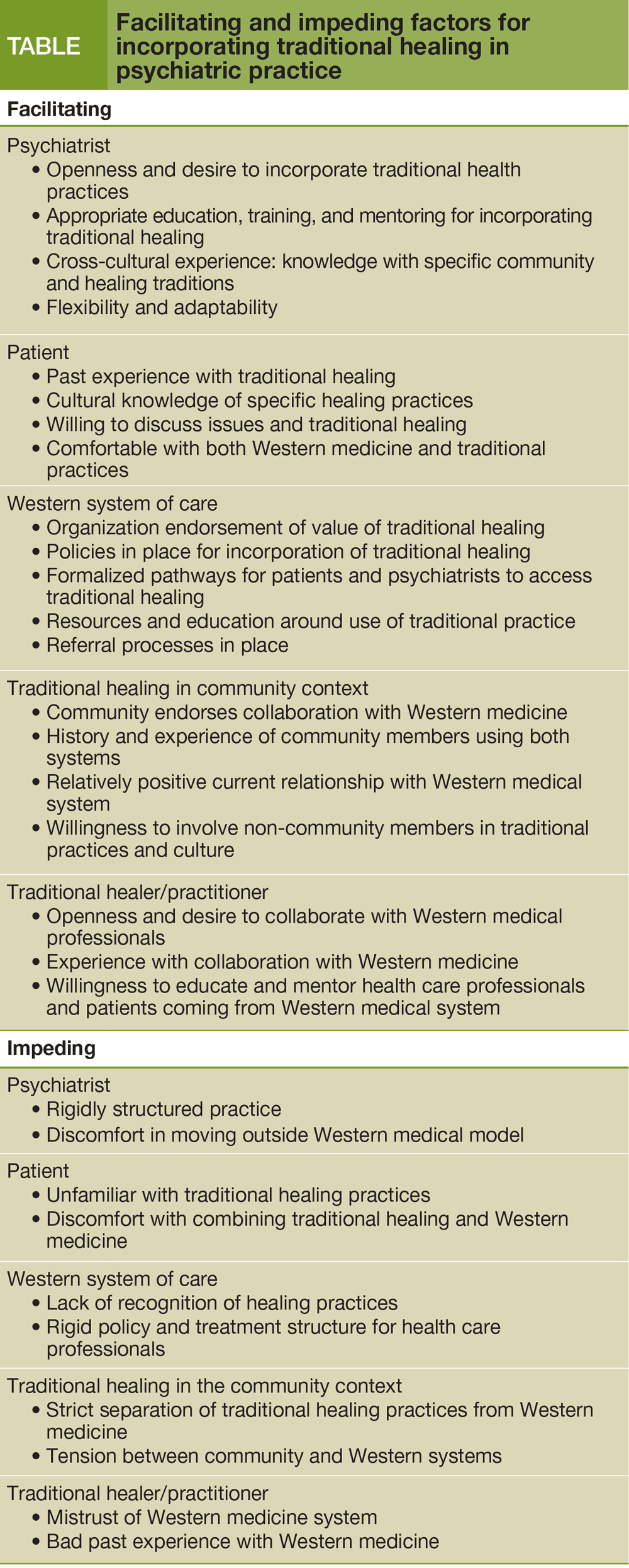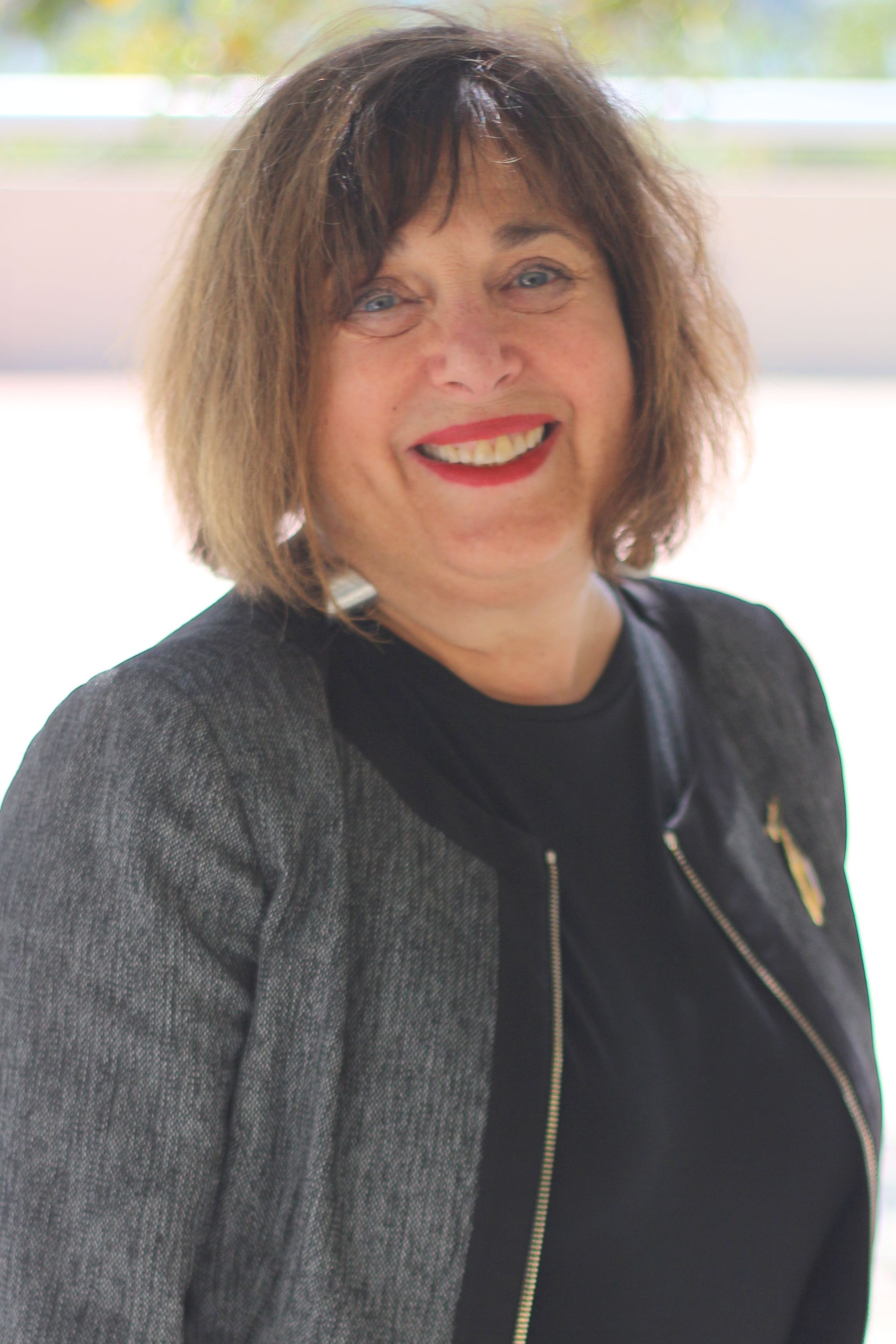Publication
Article
Psychiatric Times
Traditional Healing Concepts and Psychiatry: Collaboration and Integration in Psychiatric Practice
Author(s):
The authors share a model for psychiatrists interested in collaborating with traditional healing and medicine.
Figure. Recommendations for psychiatrist to learn and work with specific traditional healing systems

TABLE - Facilitating and impeding factors for incorporating traditional healing in psychiatric practice

Although psychiatry brings tremendous value to the amelioration and treatment of mental distress and illness, at times it falls short in providing holistic care within a patient’s broader cultural framework. Traditional healing and medicine often offer a more comprehensive, patient-centered approach to mental health treatment, which can encompass a patient’s spiritual beliefs, cosmology, and world view. For certain patients, a combination of Western psychiatric treatment and traditional healing has significant potential to alleviate symptoms within the context of physical health, spiritual life, and social milieu. In some traditions, mental health is particularly relevant, cross-cutting various conceptualizations of symptoms and illnesses. Based on our experience, we share a model for psychiatrists interested in collaborating with traditional healing and medicine.
Our focus is on traditional medicine arising from a country’s indigenous cultures. We spotlight specific examples of North American indigenous healing traditions that figure importantly in our clinical and program experience with rural Native American veterans. Our purpose is to illustrate the possible synergies that promise greater benefit for these patients than either practice pursued independently.
The use of traditional medicine is found in cultures throughout the world, and it is often encountered by US psychiatrists working with immigrant and refugee populations. Incayawar and colleagues1 provide a number of specific examples of other cultures and conceptual models of collaboration between psychiatrist and traditional healers.
Traditional healing and mental health
The literature pertaining to traditional healing practices in mental health is largely descriptive and therefore is limited in its rigor by today’s scientific standards.1 Indeed, there is an active debate as to whether current Western scientific methods are appropriate for examining the nature, processes, and outcomes of traditional healing. Part of this debate revolves around a historical monopoly of the study of traditional healing by Western, nonindigenous researchers whose views typically lie outside the cultural perspectives that inform a particular healing tradition.2
The description of indigenous healing traditions in North America dates to the 1500s, when early European settlers began co-opting and adapting treatments with Native American traditional healing.3 The earliest reports from “modern” psychiatry date to the 1940s and are best illustrated by the Leightons’4 work on psychotherapeutic aspects of the Navajo religion. Since the 1940s, a rich body of literature augmented by more recent epidemiological research began to document the importance of concurrent use of biomedical and traditional healing among Native Americans across a diverse range of tribes.1,5-7 Gone8 described parallel therapeutic processes and the possibility of integrating Native American concepts and healing traditions into psychotherapy.
Several major themes have emerged. Among them are the importance of concurrent, rather than mutually exclusive, pursuit of biomedical and traditional healing, and the feasibility as well as benefit of combining these approaches as treatment for Native American patients.9 However, this literature is largely silent with respect to how clinicians can address these issues in their individual practices and programs.
Incorporating traditional healing in practice
The Table presents our model for incorporating traditional healing in psychiatric practice; 5 key components influence the successful inclusion of traditional healing:
• The psychiatrist
• The patient
• The Western system of care in which treatment takes place
• The traditional healing in the context of the community
• The traditional healer/practitioner
For each of these components, we identify factors that can either facilitate or impede therapeutic implementation. By highlighting these factors, we hope to provide guidance on how to incorporate traditional healing in the clinical setting to maximize the likelihood of successful patient engagement. Our experience has shown that many of the impeding factors can be minimized if clinicians are able to identify them and develop plans to overcome these barriers.
The psychiatrist
Openness toward and a desire to use traditional healing are perhaps the most important qualities for a psychiatrist to embrace in order to move with comfort between different frameworks for disease, illness, and healing. The psychiatrist must commit to becoming a “serious student” of the specific healing tradition and culture within which he or she hopes to work.9 Moreover, he must understand the need to collaborate with cultural facilitators as needed. Specific recommendations are presented in the Figure.
While the psychiatrist is encouraged to pursue all of these activities, the most valuable may be identifying and working with mentors who represent the healing tradition of interest and with psychiatric colleagues who have experience working with traditional healers. Our VA programs support two types of cultural facilitators: employees referred to as tribal/telehealth outreach workers (TOWs) and volunteers who are tribal veterans’ representatives (TVRs). TOWs and TVRs are most often veterans as well as members of the specific community in which they work. Each engages community members in the treatment system and educates health care professionals about key aspects of the local context critical to therapeutic process and patient outcomes.10,11
The patient
It is important to recognize whom to appropriately engage in dialogue about traditional healing and its personal relevance. The Table lists general patient characteristics that suggest a potential place for traditional healing in the process of care. The psychiatrist performs a detailed cultural history as well as a general history of the patient, with general components as outlined by the DSM-5 cultural formulation. The cultural history consists of information on native language, cultural background, spiritual views, and personal religious history. The general history includes cultural beliefs surrounding healing, mental health, and medical illness, as well as any past experience with traditional healing. Ultimately, the patient decides whether to engage a traditional healer in the treatment process.
The psychiatrist provides education, links to information, and referral to local options, but he does not prescribe traditional treatments or practices. It is appropriate to discuss the risks and benefits of traditional treatment in the context of other medical illnesses. For example, a patient with depression, diabetes, and cardiovascular disease who wishes to participate in a Northern Plains Sweat Lodge Ceremony should be informed of the potential impact on health resulting from dehydration and fasting. In such cases, the patient should be encouraged to discuss this type of ceremony with his primary care physician and the Sweat Lodge leader so that he can anticipate and minimize the potential medical risks.12 Once it is determined that the patient is seeking traditional healing, the patient and psychiatrist embark on a sustained dialogue about the perceived effects of the treatment.
Western system of care
One of the most important factors for psychiatrists who work for a health care system is knowing how their system regards traditional healing-namely, whether there is formal acknowledgment, policies, and structures in place to support collaboration with traditional healers. An example of such a formal system endorsement can be found in the Indian Health Service, which for several decades has endorsed and provided guidance for mental health professionals who work with traditional healers.13
In some instances, patients might request the involvement of traditional healing in a hospital or clinic setting. This works best when the health care system has processes in place to guide the collaboration. The first step is that a dialogue takes place between the Western medical treatment team and the traditional healer(s) about roles, treatment processes of the two systems, and pathways of communication regarding patient care.
Traditional practice
Clinicians who actively endorse both Western medicine and traditional healing can initiate conversations with patients on these issues and can help develop respectful, appropriate lines of communication with local traditional healers. A willingness on the part of traditional healers to involve non-community members in traditional healing-as observers, consultants, or even collaborators-is strongly related to the historical relationships that are part of the cultural identity of the principals and deeply affect whether special, often protected, knowledge is shared.
In addition to the factors noted above, traditional healers will vary in their interest and willingness to collaborate with Western practitioners. Respectful, authentic inquiries by the latter, in an effort to meet the needs of their patients, often are well received. Although constrained by local protocols regarding disclosure and protection of special knowledge, many traditional healers welcome the opportunity to educate patients and Western practitioners about their healing traditions and treatments.
Special considerations: psychiatrist as traditional practitioner
Some psychiatrists may be familiar with or acquire training in a specific technique or intervention (the roots of which spring from local healing traditions) that can pose special challenges. A psychiatrist actively engaged in traditional healing practices should be well versed in such practices, exquisitely sensitive to determining when they are appropriate, and openly endorsed by the community. The psychiatrist must be clear about patient informed consent for treatment as well as the conceptual model guiding his therapeutic efforts and recommendations. Awareness of potential ethical issues that can arise when providing traditional treatment, including dual roles, boundaries, and providing spiritual treatments to patients, is essential, as is consultation with colleagues who are well versed in both the Western and the traditional systems.
CASE VIGNETTE
A 28-year-old Native American military veteran who lives on a rural Northern Plains reservation is being seen in a VA telepsychiatry clinic. He had served 2 combat tours in Afghanistan as a Marine. He had presented with significant PTSD related to military trauma. He had been in treatment for 2 years and previously underwent 12 sessions of exposure therapy, with some decrease in specific memories and intrusive thoughts. At the time of the initial involvement in traditional healing, he was taking prazosin 5 mg nightly for nightmares but was not interested in additional medications. Although the prazosin and exposure therapy reduced his PTSD symptoms, the patient continued to struggle with appreciable anger at work that caused conflicts with co-workers and jeopardized his employment status.
The patient had been raised by his grandmother, a fluent speaker of their tribal language. He grew up engaged in cultural activities affiliated with his tribe, including attending pow wows and other ceremonies. But he had not participated in these activities since returning from military service. The psychiatrist explored the patient’s previous cultural experiences. He determined that the patient was interested in renewing this aspect of his previous life, which led to discussions about traditional healing options.
The psychiatrist consulted the clinic’s VA tribal outreach staff to identify a local healer experienced in working with veterans. The healer, psychiatrist, and tribal outreach worker met to discuss the VA program, possible collaboration, and how to appropriately introduce traditional healing into the therapeutic process.
The patient subsequently began working with the healer while continuing his psychiatric treatment through the clinic. He participated every other week in Sweat Lodge ceremonies. Within a month of engagement, the patient showed significant improvement in managing his anger and stress, and was able to function well at work. The psychiatrist continued to work with the patient to manage the pharmacological regimen and better align supportive therapy with discussions, dialogue, and encouragement of continued participation in the Sweat Lodge.
Acknowledgments-This article builds on the work of James Shore (1940-2013),9 who was among the first cohort of Indian Health Service psychiatrists whose career focused on improving the mental health of American Indians and Alaska Natives. He was a colleague and mentor to us and to a generation of mental health providers in this arena. His ideas, guidance, and principles of respect and collaboration form the foundation of these models.
This work was supported by the Veterans Rural Health Resource Center-Western Region, Salt Lake City, Utah-Field Office for the Office of Rural Health. The views expressed in this article are those of the authors and do not necessarily reflect the position or policy of the Department of Veterans Affairs. This manuscript was reviewed by the Office of Rural Health.
Disclosures:
Dr Shore is Native Domain Lead at the Veterans Rural Health Resource Center-Western Region, Office of Rural Health, Department of Veterans Affairs, Salt Lake City, and an Associate Professor at the Centers for American Indian and Alaska Native Health, School of Public Health, University of Colorado Denver, Aurora. Mr Richardson is Minority Veterans Program Coordinator for the VA Rocky Mountain Healthcare Network (VISN 19), Fort Harrison, Mont. Dr Bair is Director of the Veterans Rural Health Resource Center-Western Region, Office of Rural Health, Department of Veterans Affairs, Salt Lake City. Dr Manson is Director of the Centers for American Indian and Alaska Native Health, School of Public Health, University of Colorado Denver, Aurora. The authors report no conflicts of interest concerning the subject matter of this article.
References:
1. Incayawar M, Wintrob R, Bouchard L, eds. Psychiatrists and Traditional Healers: Unwitting Partners in Global Mental Health. London: Wiley-Blackwell; 2009.
2. Henderson J. Legitimacy and contextual issues in traditional Lakota Sioux healing. In: Incayawar M, Wintrob R, Bouchard L, eds. Psychiatrist and Traditional Healers: Unwitting Partners in Global Mental Health. London: Wiley-Blackwell; 2009:13-24.
3. Dary D. Frontier Medicine. New York: Random House; 2008.
4. Leighton AH, Leighton DC. Elements of psychotherapy in Navajo religion. Psychiatry. 1941;4:515-523.
5. Marbella AM, Harris MC, Diehr S, et al. Use of Native American healers among Native American patients in an urban Native American health center. Arch Family Med. 1998;7:182-185.
6. Buchwald D, Beals J, Manson SM. Use of traditional health practices among Native Americans in a primary care setting. Med Care. 2000;38:1191-1199.
7. Novins DK, Beals J, Moore LA, et al; AI-SUPERPFP Team. Use of biomedical services and traditional healing options among American Indians: sociodemographic correlates, spirituality, and ethnic identity. Med Care. 2004;42:670-679.
8. Gone JP. Psychotherapy and traditional healing for American Indians: exploring the prospects for therapeutic integration. Couns Psychol. 2010;38:166-235.
9. Shore JH, Shore JH, Manson SM. American Indian healers and psychiatrists. In: Incayawar M, Wintrob R, Bouchard L, eds. Psychiatrist and Traditional Healers: Unwitting Partners in Global Mental Health. London: Wiley-Blackwell; 2009:123-134.
10. Shore J, Kaufmann LJ, Brooks E, et al. Review of American Indian veteran telemental health. Telemed J E Health. 2012;18:87-94.
11. Kaufmann LJ, Richardson WJ Jr, Floyd J, Shore J. Tribal veterans representative (TVR) training program: the effect of community outreach workers on American Indian and Alaska Native veterans access to and utilization of the Veterans Health Administration. J Community Health. 2014;39:990-996.
12. Livingston R. Medical risks and benefits of the sweat lodge. J Altern Complement Med. 2010;16:617-619.
13. Department of Health and Human Services: Indian Health Service. Special General Memorandum 94-8. Indian Health Manual; 1994. http://www.ihs.gov/ihm/index.cfm?module=dsp_ihm_sgm_main&sgm=ihm_sgm_9408. Accessed May 5, 2014.






